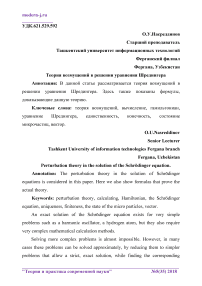Состояния и функции системы защиты информации
Автор: Муроз А.В., Селиванова Т.В.
Журнал: Теория и практика современной науки @modern-j
Рубрика: Математика, информатика и инженерия
Статья в выпуске: 5 (35), 2018 года.
Бесплатный доступ
Статья посвящена рассмотрению состояний и функций системы защиты информации, а также определению их основных свойств и назначения для сферы безопасности.
Система защиты информации, функции системы, состояния системы, воздействие
Короткий адрес: https://sciup.org/140273211
IDR: 140273211
Текст научной статьи Состояния и функции системы защиты информации
An exact solution of the Schrödinger equation exists for very simple problems such as a harmonic oscillator, a hydrogen atom, but they also require very complex mathematical calculation methods.
Solving more complex problems is almost impossible. However, in many cases these problems can be solved approximately, by reducing them to simpler problems that allow a strict, exact solution, while finding the corresponding corrections. The development of methods for approximate solutions of problems by reducing them to the corresponding ones, simpler, with the calculation of necessary corrections, and is the content of perturbation theory. more simple with the calculation of the necessary spikes and is the content of perturbation theory.
There is an equation
Ĥψ = Eψ
The exact solution of this, however, is impossible. Then it is necessary from the Hamiltonian Ĥ to select the terms Ĥº for which there exists an exact solution, so that the equation
Ĥºψº = Eºψº is solved: ψº and Eº are known. In this case, this solution can be taken as the zeroth approximation for the initial problem, the Hamiltonian of which can be represented as the sum of two terms:
Ĥ = Ĥº + Ŵ where Ŵ = Ĥ-Ĥ is called the perturbation operator if it is assumed that the perturbation is small, then we can seek an approximate solution in the form of a series in powers of this perturbation. The results of perturbation theory will be valid, then when the correction is small, therefore, for this it is necessary that condition
|Wnm|<<|Eºn-Eºm| where En is the eigenvalue of the wave function, respectively: ψn1, ψn2, ..., ψn, then the state with energy En is called degenerate. Or, to any value of En (or any other quantities) there correspond ƒ the number of distinct eigenfunctions. In order for the solution of the Schrödinger equation to be meaningful, it is necessary to impose the following conditions on the wave function ψ.
-
1. Uniqueness. The meaning of ψ is the probability amplitude, therefore, ψ * • ψ is the probability density, and ψ * • ψ dv is the probability to find a particle in the volume dv near the point x, y, z, at time t. This probability is a well-defined quantity, therefore, ψ must be a single-valued function of the coordinates and time,
-
2. Finiteness. In order for the probability to be finite, it is necessary that
-
3. The state of the microparticles is described by the wave function ψ,
otherwise we get that for the same point κ there are two or more probabilities that are devoid of any physical meaning.
the function ψ be everywhere finite and, together with its first derivative, vanishes at infinity.
which is an analog of the trajectory in classical physics. The state of a quantum system in space and time must change continuously. And this means that ψ must be a continuous function. In revenge with continuity of the wave function ψ, its first derivative must also be continuous. From the point of view of mathematics, this is a natural requirement, since the Schrödinger equation is a second-order equation in spatial coordinates, in order for it to make sense everywhere, it is necessary that both ψ and Δψ be everywhere continuous.
Let's consider some special cases:
Vector of the probability current density. In this case, the normalization condition does not depend on time (stationary case). If at some instant t
∫ψ*(x,y,z,t) ψ(x,y,z,t)dxdydr=1
this equality is preserved at all times. Indeed, the sloping, ∫ψ * ψdv = ƒ (t) we find :
*
dƒ ∂ψ*
dt ∂t
ψdv + ∫ψ* dv
Δt
Substituting δψ and δψ*
δt
δt
for their expressions from conservation, we obtain
the
Schrödinger equation, after
dƒ dt
∫div[ψ*Δψ-ψΔψ*]dv
2m
iħ
2m
∫[ψ*Δψ-ψΔψ*] n ds
Since ψ and Δψ at infinity turn to zero, then df and, consequently, f (t) = const = 1.
=0
Δt
From the preceding equation, we can write for an arbitrary volume V:
∫{ (ψ*ψ)+div[ (ψΔψ*-ψ*Δψ)]}dv=0
∂t 2m
The equation coincides in form with the equation of continuity
∂Q
+divj=0
dt in hydrodynamics and the theory of electricity. Since ψ * ψ = w is the probability density, the vector iħ j= (ψΔψ*-ψ*Δψ)
2m is called the probability current density vector. If the system is described by the real wave function ψ * = ψ, then j = 0.
Список литературы Состояния и функции системы защиты информации
- Состояние и функции системы защиты информации [Электронный ресурс]: https://studopedia.su/19_87850_sostoyaniya-i-funktsii-sistemi-zashchiti-informatsii.html
- Функции и задачи системы защиты информации [Электронный ресурс]: http://siblec.ru/index.php?dn=html&way=bW9kL2h0bWwvY29udGVudC84c2VtLzA2Mi8xMy0xLmh0bQ==


